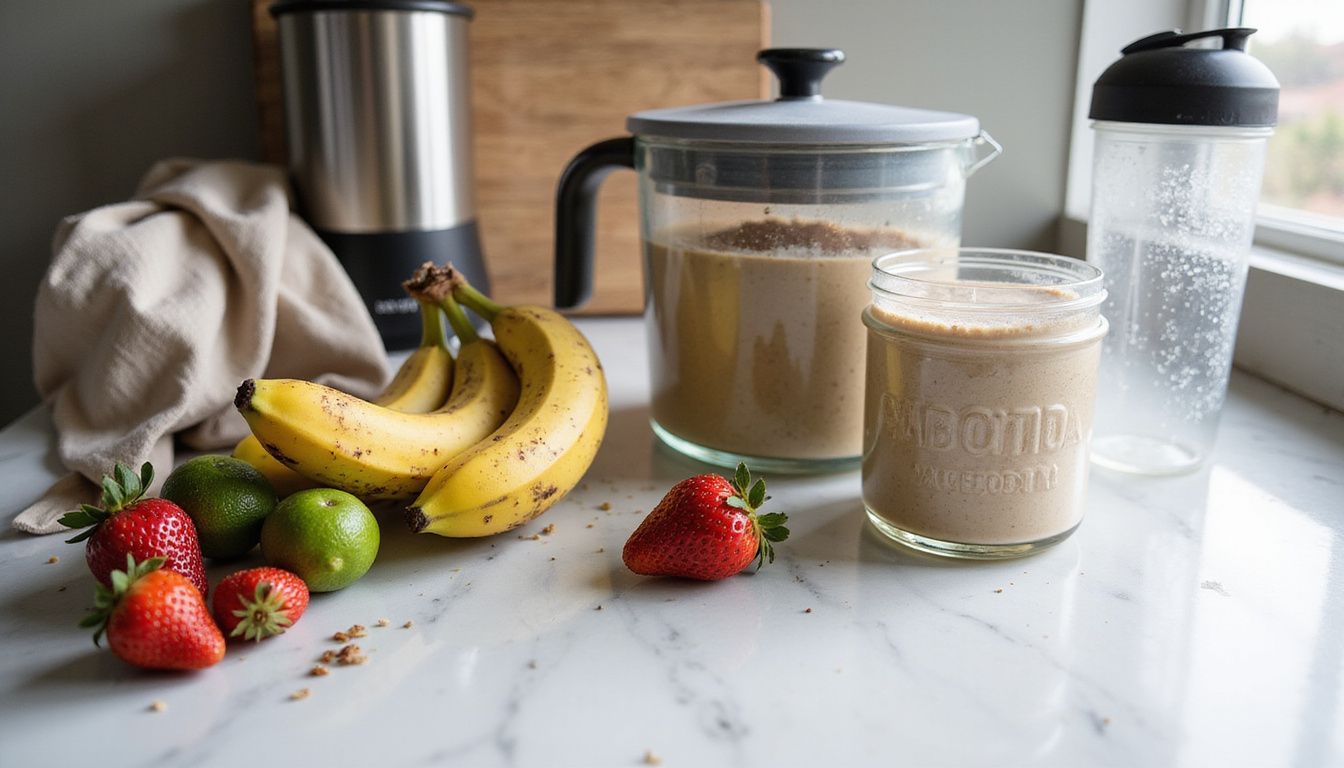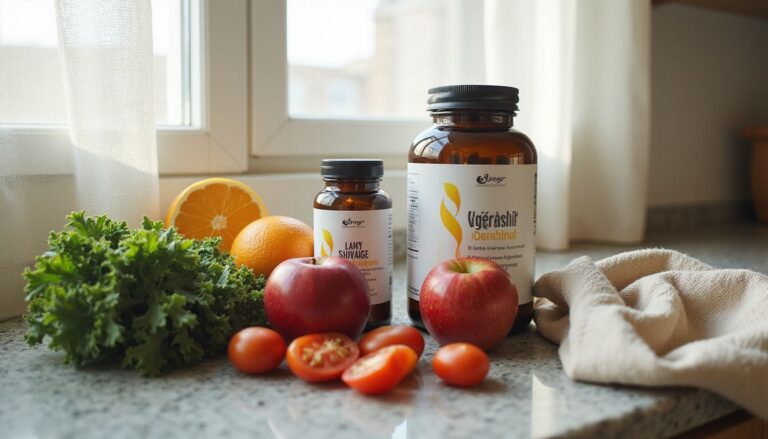Best Protein Shakes: Top Picks For Powder, Whey, And Protein Drink
Our Nutrition Assistant AI Suite will transform your body. You will lose fat, get toned, and build muscle. Gain confidence and optimal health.
You want strong muscles, steady energy, and quick recovery, yet the protein shake aisle can feel crowded. A simple rule helps: most adults need about 0.8 grams of protein per kilogram of body weight each day. Active people often need more.
This guide compares powder, whey, and ready-to-drink shakes for taste, nutrition, and convenience. You will learn how to choose a protein shake that fits your goals, budget, and diet.
Use these tips to pick a protein drink that truly supports your routine.
Key Takeaways
- The average adult needs about 0.8 grams of protein per kilogram daily. Active people should aim for 1.2 to 2.0 grams per kilogram to support training.
- Ready-to-drink shakes such as Fairlife Core Power offer up to 26 grams of protein per serving to support recovery. Plant-based options like Ripple provide 20 grams per bottle.
- For weight management, choose shakes with under 7 grams of added sugar, at least 15 grams of protein per serving, and useful extras like fiber or vitamins.
- Koia includes 6 grams of fiber per bottle for digestion support. Meal replacements like Kate Farms provide about 330 calories and 27 micronutrients per serving.
- Ready-to-drink options are shelf-stable and portable. Many come in vegan, gluten-free, or lactose-free formulas to fit allergies and preferences.

Benefits of Protein Shakes

Protein shakes make it easier to meet daily protein needs on busy days. Many people use them to support training, recovery, and balanced eating.
How do protein shakes support muscle growth and recovery?
After hard exercise, your muscles need amino acids, the building blocks of protein. Whey protein and quality plant-based protein powder deliver those amino acids quickly to help repair muscle fibers and grow stronger.
Choose shakes with 20 to 30 grams of protein per serving; this matches sports nutrition guidance shared by dietitians such as Kristy Baumann, RD, LD. Getting at least 20 grams of high-quality protein within 30 minutes after a workout can improve muscle recovery and growth.
Protein provides the raw materials your body uses to fix tiny tears from exercise. For instance, Fairlife Core Power Protein Shake offers 26 grams per bottle, plus calcium for bone support.
On days when I could not face a full meal after training, a ready-to-drink shake helped me meet my protein goals without stress.
For best results, aim for at least 1.2 to 2.0 grams of protein per kilogram if you’re active, according to research-backed sports nutrition guidelines.
Pick complete proteins, which contain all essential amino acids. Whey is a complete dairy protein. Pea and soy are reliable plant choices. These fit many diets, including vegan and gluten-free plans.
Can protein shakes help with weight management and fat loss?
Protein shakes can support weight control by increasing fullness. Protein slows digestion, so you feel satisfied longer and may eat fewer calories later.
Lindsay Allen, MS, RDN, notes that higher protein intake from whey protein isolate or pea protein often leads to better satiety. That makes it easier to stick to your calorie target.
Check labels. Some products are designed for bulking and contain more sugar and calories. If weight loss is your goal, pick lower calorie options with fiber to help you stay full.
Healthy adults can safely eat up to 2.0 to 3.5 grams of protein per kilogram of body weight in many cases. Still, whole foods add vitamins and minerals that some shakes lack. If your shake is low in fiber, plan fiber-rich foods at other meals to avoid getting hungry later.
Why are protein shakes a convenient source of nutrients?
Shakes save time. Ready-to-drink choices like OWYN Vegan Protein Shake provide 20 grams of plant protein per bottle and avoid common allergens.
Fuel for Fire Protein Smoothies come in portable pouches for fast pre-workout fuel. Shelf-stable products last longer than fresh meals and are easy to keep at your desk or in your gym bag.
I often grab a pre-mixed option such as Slate Milk Shake after a workout. It covers protein needs when I cannot prepare food, and it keeps my energy steady.
Types of Protein Shakes
Different protein types work in different ways. A quick overview helps you match the right option to your goals.
What is whey protein?
Whey protein comes from milk during cheesemaking. Many high-protein shakes use whey because your body absorbs it quickly, which is helpful after workouts.
Products like Fuel for Fire Original Smoothies include whey and offer about 10 grams per serving. Fairlife Core Power uses ultra-filtered milk to deliver a rich source of whey and other milk proteins.
People with lactose intolerance may tolerate whey isolate or lactose-removed formulas better. In my experience, lactose-free varieties reduced bloating. Whey can raise daily protein intake when you are trying to build muscle or manage weight.
What is casein protein?
Casein is another milk protein, but it digests slowly. That slow release provides amino acids over several hours, which can support overnight recovery or longer gaps between meals.
Athletes often use casein before bed to help meet daily protein targets and protect muscle. One serving can provide up to 30 grams of protein per scoop or bottle, depending on the product.
If you want steady fullness, casein can help. If you prefer dairy-free choices, the next section covers plant-based proteins such as pea, soy, and rice.
What are plant-based protein options like pea, soy, and rice?
Plant-based proteins give you dairy-free choices. Pea protein is popular because it is easy to digest and has a smooth mouthfeel. Ripple Protein Shake provides 20 grams of pea protein per bottle.
Brown rice and chickpea proteins appear in blends like Koia Plant-Based Protein Shake, which offers 18 grams per bottle. Soy protein is a complete protein, meaning it contains all essential amino acids.
Brands such as Orgain Organic Nutrition Plant Protein Shakes blend pea, brown rice, and seeds to reach about 16 grams per serving. These are often vegan and gluten-free, and they avoid common allergens.
I have used brown rice and pumpkin seed blends and found them gentle on my stomach with no chalky aftertaste. These can help you meet your protein goals if you avoid milk or other allergens.
What are meal replacement shakes?
Meal replacement shakes combine protein, carbohydrates, and fat to replace a full meal. They usually provide 300 to 350 calories per serving.
Kate Farms Nutrition Shake offers 16 grams of protein, 330 calories, and 27 micronutrients including vitamin D, calcium, and iron. Many are vegan, gluten-free, and dairy-free to fit a wide range of diets.
Compared to standard protein shakes, meal replacements provide more total nutrition and longer-lasting fullness. They help manage calorie intake and offer a portable meal when time is tight.
How to Choose the Best Protein Shake
Start with your goals. Then match the protein source, nutrition profile, flavor, and cost to your daily routine.
How to evaluate protein source and quality?
Check the protein type. Whey and casein are animal-based, while pea, rice, and pumpkin seed are plant-based. Dietitians often suggest at least 15 grams of protein per serving for a meaningful boost.
Read ingredient lists carefully. In recent reviews, products delivered their stated protein amounts, typically 20 to 60 grams per serving.
Grass-fed or organic options may appeal if you want to avoid artificial sweeteners or added sugar. Choose a source that fits your diet, such as avoiding milk or soy, and supports your goals.
Why check sugar, fat, and calorie content?
After you confirm the protein source, look at the rest of the label. Many shakes pack in added sugar, which can work against weight goals.
Aim for fewer than 7 grams of added sugar per serving. For example, Slate Milk Shake has 100 calories, 1 gram of sugar, and 2 grams of fiber per bottle, which suits those watching calories or sugar.
Too much sugar or fat can push you over your daily targets. Koia Plant-Based Protein Shake contains 190 calories, 6 grams of sugar with 4 grams added, and 6 grams of fiber.
Compare calories, sugar, and fiber to find the best fit, whether you want a chocolate milk style drink, a plant-based protein shake, or a higher protein and fiber option.
How to choose flavor and texture preferences?
Taste and texture matter because they determine if you will drink the shake often. Ripple Protein Shake offers a classic chocolate milk taste without a strong aftertaste.
Vanilla fans have many choices, including cold brew coffee or fruit-inspired flavors. For creamier textures, look at OWYN Vegan Protein Shakes. If you like thinner drinks, Slate Milk Shake feels lighter than a thick smoothie.
On busy mornings, I prefer smoother options. Thicker blends kept me fuller when used as a meal replacement. Check labels for sweeteners such as sucrose or sugar substitutes if you are sensitive to sweetness.
What additional nutrients should I look for (e.g., vitamins, probiotics)?
Shakes that include added vitamins and minerals can strengthen your overall diet. Orgain Organic Nutrition Plant Protein Shake includes vitamin C, vitamin D, vitamin B12, and iron.
Kate Farms Nutrition Shake supplies 27 micronutrients, including vitamin D, calcium, and iron, plus a plant blend. Other useful extras include omega-3 fats, prebiotics, probiotics, and greens.
Iconic Protein Drinks offer 40 percent of daily calcium plus greens. Extras like calcium, iron, or fiber can fill common gaps while you meet protein goals.
How does budget and availability affect your choice?
Costs vary widely. For example, OWYN Vegan Protein Shake often lists at about $42, sometimes lower on Amazon. Koia may sell around $39, and Slate Milk Shake is about $36, with periodic sales.
Subscription discounts can lower the price per serving. Not every store stocks every brand, so you may need to order items like Fairlife Core Power or Ripple online.
Balancing cost, availability, and nutrition helps you stay consistent without overspending. Check retailer sites monthly to catch sales and keep your protein intake on track.
Best Overall: Fairlife Core Power Protein Shake
Fairlife Core Power combines high-quality milk protein with crowd-pleasing flavors. Many people use this protein supplement to reach daily targets for muscle recovery and growth.
What are the features of Fairlife Core Power Protein Shake?
Each bottle provides 26 grams of protein from ultra-filtered milk. You also get 50 percent of the Reference Daily Intake for calcium, 25 percent for vitamins A and D, and 20 percent for potassium.
Lactase enzyme is added for easier digestion if you are lactose intolerant. Flavors include strawberry banana, banana, and vanilla. The Elite version bumps protein to 42 grams per bottle.
The drink is shelf-stable but tastes best chilled. I often grab one on busy mornings to cover a large share of my protein needs quickly.
What are the pros and cons of Fairlife Core Power Protein Shake?
Core Power has a smooth texture with no added sugar. It uses sweeteners such as stevia, monk fruit, acesulfame-K, and sucralose instead of table sugar.
The shake is gluten-free and lactose-free and includes 2 grams of fiber. Some people may react to carrageenan, a thickener that can bother sensitive stomachs. Others dislike the taste of mixed sweeteners.
Read labels closely. Aim to get the protein you need without extra ingredients you prefer to avoid.
Best Vegan Option: Ripple Protein Shake
Ripple relies on pea protein, which makes it a solid choice if you avoid dairy or eggs. The formula includes flax and prebiotic fiber for digestive support.
What are the features of Ripple Protein Shake?
Each bottle provides 20 grams of plant-based protein from peas. The texture is smooth, and the chocolate flavor tastes like classic chocolate milk without a strong aftertaste.
Every serving provides more than 500 milligrams of calcium, about 45 percent of daily value, and 4 milligrams of iron, about 25 percent of daily needs. One bottle has 200 calories and 9 grams of added sugar from cane sugar and monk fruit extract.
Flavors include chocolate, vanilla, and coffee. The coffee variety contains 75 milligrams of caffeine per bottle. If you prefer plant-based ingredients such as pea and flax, this option stands out.
What are the pros and cons of Ripple Protein Shake?
Ripple delivers dairy-free protein with meaningful calcium and iron, which can support bones and energy. The texture is smooth and free of a fake aftertaste. Many appreciate that it avoids common dairy allergens.
Each bottle contains 9 grams of added sugar, which might not fit very low-sugar plans. The coffee flavor includes caffeine, which may not suit children or those avoiding stimulants.
If you want a plant-based protein source and simple flavor choices, Ripple is a practical pick.
Best High-Fiber Shake: Koia Plant-Based Protein Shake
Koia offers a mix of plant protein and fiber to support digestion. It works well for people who want fullness and steady energy.
What are the features of Koia Plant-Based Protein Shake?
Each bottle provides 18 grams of protein from brown rice, pea, and chickpea. You get 190 calories and 6 grams of total sugar, with 4 grams added.
Every serving includes 6 grams of fiber for digestive support. Sweetness comes from organic cane sugar and monk fruit.
Flavors include Chocolate Banana, Cacao Bean, Cold Brew Coffee, and Vanilla, and all are vegan. The shake is non-GMO and contains no dairy or soy. It is gluten free and fits many dietary needs.
With moderate calories and higher fiber, Koia can help with weight control and hunger between meals.
What are the pros and cons of Koia Plant-Based Protein Shake?
Koia supplies 6 grams of fiber per bottle, which supports gut health and helps you feel full longer. It avoids most major allergens except tree nuts. The formula contains almonds and coconuts, which is a concern if you have nut allergies.
Each serving includes 4 grams of added sugar. If you drink more than one bottle a day, that sugar can add up.
For a fiber-forward, plant-based choice, Koia is a strong option, but nut-allergic readers should steer clear.
Best for Chocolate Lovers: OWYN Dark Chocolate Protein Shake
OWYN Dark Chocolate offers a rich cocoa taste and a creamy texture. It is plant-based and designed to be easy on digestion.
What are the features of OWYN Dark Chocolate Protein Shake?
OWYN provides 20 grams of plant protein from pea and pumpkin seed. Together they supply all essential amino acids needed for muscle repair.
Each bottle includes omega-3 fats and delivers 20 percent of daily iron. You get 3 grams of fiber and only 4 grams of added sugar.
This shake is shelf-stable, so you can store it at room temperature. The flavor is deep and chocolatey without using dark chocolate flour or nut ingredients, which helps those with allergies.
What are the pros and cons of OWYN Dark Chocolate Protein Shake?
OWYN is vegan, gluten-free, and allergen-friendly. It includes a greens blend with broccoli, spinach, and kale, plus prebiotics for gut health. People who avoid soy, dairy, and nuts often find it fits well.
The 4 grams of added sugar may still be too much for very strict low-sugar plans. The greens blend is nutritious but could interact with blood thinners in some cases.
Match this shake to your goals and any medical needs. If you want low calories next, see Slate Milk Shake.
Best Low-Calorie Option: Slate Milk Shake
Slate is a low-calorie protein drink for people watching energy intake. It delivers protein without extra sugar or many additives.
What are the features of Slate Milk Shake?
Each bottle provides 20 grams of protein from ultra-filtered skim milk. You get only 100 calories, 1 gram total sugar with zero added sugar, and 2 grams of fiber.
The sweet taste comes from stevia and monk fruit. Slate is lactose-free, gluten-free, soy-free, and nut-free, which helps people with sensitivities. Flavors include Dark Chocolate, French Vanilla, Classic Strawberry, and caffeine-spiked options.
As someone who avoids lactose and nuts, I appreciated the taste and light feel after the gym.
What are the pros and cons of Slate Milk Shake?
With only 100 calories and no added sugar, Slate supports weight control. The thinner texture can feel refreshing as a quick snack or post-workout drink.
Slate tastes best chilled. The aluminum can is less portable once opened compared to a screw-cap bottle, which can be awkward if you cannot finish it right away.
I liked using Slate before early runs for fast fuel, though saving an opened can during long shifts proved tricky.
Best Meal Replacement Shake: Kate Farms Nutrition Shake
Kate Farms works well if you need a balanced meal in a bottle. It brings plant protein, fiber, and a wide range of vitamins and minerals.
What are the features of Kate Farms Nutrition Shake?
Each bottle provides 16 grams of organic yellow pea protein and 330 calories. That calorie level supports people with higher energy needs.
You get 18 grams of sugar from agave and brown rice syrup solids and 6 grams of fiber, which supports blood sugar control and digestion. The shake includes 27 micronutrients such as vitamin D, calcium, and iron, plus a plant-based phytonutrient blend.
It is vegan, gluten-free, and dairy-free to fit many restrictions. If you want a well-rounded meal replacement with prebiotic nutrition and no common allergens, this is a convenient option.
What are the pros and cons of Kate Farms Nutrition Shake?
Kate Farms offers a balanced mix of protein, carbs, fat, and micronutrients, making it suitable as a true meal replacement. The formula includes plant compounds such as tart cherry.
Two potential downsides are sweetness and price. Each bottle has 18 grams of sugar and the cost is often higher than many alternatives.
If budget is tight or you prefer less sweet flavors, another option may fit better.
When to Drink Protein Shakes
Timing helps you get more from your shake. Use it before or after workouts, or as a meal or snack when needed.
What are the benefits of drinking protein shakes pre-workout?
A pre-workout shake provides quick protein and carbohydrates for energy. That matters if you train early or have limited time to eat.
Fuel for Fire Original Smoothies contain 10 grams of protein and 15 grams of carbs per pouch. You can sip it right before a session because the format is fast and portable.
Some people also feel they recover better when they get nutrition before training. If you prefer custom blends, powders let you add fruit or nut butter for extra carbs and flavor.
How do protein shakes aid post-workout recovery?
After exercise, muscles need protein to repair. Shakes deliver essential amino acids that help fix stressed fibers.
Kristy Baumann, RD, LD, suggests getting at least 20 grams of protein plus carbohydrates within 30 minutes after a workout. Fairlife Core Power offers 26 grams of high-quality protein. For plant-based fans, OWYN Vegan Protein Shake covers all essential amino acids.
When I followed this timing after lifting sessions, I felt less sore and bounced back faster.
Can protein shakes replace a meal?
Some shakes can stand in for a meal, especially if they provide enough calories and balanced nutrients. Kate Farms Nutrition Shake delivers 330 calories, 16 grams of protein, and 6 grams of fiber, which fits the meal replacement profile.
Dietitians recommend at least 300 to 350 calories with protein, carbs, and healthy fat for a satisfying meal. Prebiotic fiber and a source of fat improve fullness.
Shakes without carbs or fat may leave you hungry soon after. On busy mornings, I stayed full until lunch only when my shake had enough calories and fiber.
Is it good to snack on protein shakes throughout the day?
Many people use smaller shakes as snacks. Orgain Organic Nutrition Plant Protein Shake offers 16 grams of protein and 240 calories, which can bridge the gap between meals.
Higher fiber options like Koia, with about 6 grams of fiber, can reduce cravings later. Prebiotic ingredients may also support digestion.
An afternoon plant-based shake often curbed my evening snack cravings. Just watch total liquid calories to avoid overshooting your goals.
Common Misconceptions About Protein Shakes
Clearing up myths helps you use shakes wisely and safely.
Do protein shakes cause weight gain?
Protein shakes do not cause weight gain by themselves. Weight increases when you take in more calories than you burn.
Some products are high in calories and sugar by design. If you add those on top of full meals, weight can rise quickly.
National survey data show many Americans already exceed recommended protein levels. I once used a high-calorie shake after every workout and did not adjust meals. My clothes fit tighter within weeks. Choose balanced shakes, include fiber, and track total calories.
Are protein shakes safe for everyone?
Protein supplements are not ideal for every person. Oversight for supplements is limited in the United States, so quality can vary.
If you take medicines, especially blood thinners, some greens blends could interact with treatment. Consumer Reports testing in 2022 found many powders and shakes with lead levels above safe daily limits. Plant-based powders showed higher lead levels on average than dairy-based options in those tests.
Allergies are another concern. Some products contain nuts or other allergens. If you have a medical condition or take prescription drugs, talk with your healthcare provider before starting any new protein supplement.
Protein Shake FAQs
These quick answers can help you pick smarter products and use them well.
Can protein shakes help with weight loss?
Yes, they can help by increasing fullness. High-protein diets often reduce hunger and calorie intake at later meals.
A shake with 20 to 30 grams of protein may curb appetite between meals. Many shakes are low in fiber, so pair them with fruit, chia, or nuts for extra fiber and steadier blood sugar.
Check labels for added sugars and total calories, since these vary widely.
How much protein do I need daily?
The recommended dietary allowance is 0.8 grams of protein per kilogram of body weight, or about 0.36 grams per pound. A 170-pound person needs about 61 grams daily for basic needs.
Active people often need 1.2 to 2.0 grams per kilogram to support training. Older adults may aim for 1.0 to 1.3 grams per kilogram to protect muscle.
On an 1,800 calorie plan, getting 20 to 30 percent of calories from protein equals about 90 to 135 grams per day. Reach this with lean foods and, if helpful, a well-chosen protein shake.
Should I choose powder or ready-to-drink protein shakes?
Ready-to-drink shakes like OWYN and Ripple are fast and consistent. Each bottle delivers a known amount of protein, often 20 to 60 grams per serving, based on recent lab checks reported by Consumer Reports.
Protein powders are flexible and usually cost less per serving. You can adjust portions and blend in fruit or oats.
Consumer Reports has raised concerns about heavy metals in some plant-based powders. Dairy-based powders often showed lower lead levels in those tests. Pick the format that fits your routine, budget, and nutrition preferences.
Conclusion
Choosing the best protein shake depends on taste, goals, and how you like to eat. Use a protein shake with at least 15 to 20 grams per serving, low added sugar, and helpful extras like fiber or calcium.
Whey, plant-based, and meal replacement options can all support recovery, weight management, or busy mornings. Read labels, consider timing, and watch total calories. If you have a medical condition, ask a healthcare professional for guidance.
With a smart plan and consistent habits, the right protein drink can simplify your nutrition and support steady progress each day.
FAQs
1. What are the benefits of choosing protein shakes with prebiotic nutrition?
Protein shakes that include prebiotic nutrition support digestive health by feeding beneficial gut bacteria. Studies show that a healthy gut can improve nutrient absorption and overall wellness.
2. How do nut-based protein drinks compare to whey powder options?
Nut-based protein drinks offer plant-derived proteins, which may suit people with dairy allergies or those seeking vegan alternatives. Whey powders provide complete proteins and often contain higher levels of essential amino acids, making them popular for muscle recovery.
3. Are there specific nutritional differences between whey and nut (fruit) protein powders?
Whey protein typically contains more branched-chain amino acids per serving compared to nut (fruit) based powders. Nut-based options often supply extra fiber, vitamins, minerals, and sometimes natural prebiotics from their ingredients.
4. Can adding a shake with both nuts (fruits) and prebiotics help daily nutrition?
Combining nuts (fruits) and prebiotics in a shake can enhance dietary variety while supporting digestion through added fiber content. This blend may also deliver sustained energy due to slower carbohydrate release from whole food sources.
Summary: Protein shakes vary in source ingredients such as whey or nuts (fruits), each offering unique nutrients like amino acids or fiber along with potential digestive benefits when containing prebiotic nutrition.







